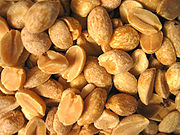 From the NYTimes and JAMA:
From the NYTimes and JAMA:Many who think they have food allergies actually do not. The true incidence of food allergies is about 8 percent for children and less than 5 percent for adults. Yet about 30 percent of the population believe they have food allergies. Even people who had food allergies as children may not have them as adults. People often shed allergies, though no one knows why.
50% of the patients coming to the allergy clinics because they had been told they had afood allergy did not really have one.
People who receive a diagnosis after one of the two tests most often used — pricking the skin and looking in blood for IgE antibodies, the type associated with allergies — have less than a 50 percent chance actually having a food allergy.
One of the biggest misconceptions some doctors have is that a positive test for IgE antibodies to a food means a person is allergic to that food.
During development, the immune system tends to react to certain food proteins, producing IgE antibodies. These antibodies can be transient and even inconsequential. There are plenty of individuals with IgE antibodies to various foods who don’t react to those foods at all.
Summary receiver operating characteristic curves comparing skin prick tests (area under the curve [AUC], 0.87) and serum food-specific IgE (AUC, 0.84) to food challenge showed no statistical superiority for either test. Elimination diets are the mainstay of therapy but have been rarely studied. Immunotherapy is promising but data are insufficient to recommend use. In high-risk infants, hydrolyzed formulas may prevent cow's milk allergy but standardized definitions of high risk and hydrolyzed formula do not exist.
What is the solution?
See a board-certified allergist for correct diagnosis and treatment - you can find an allergist in your area here: http://www.acaai.org/patients/Pages/locate-an-allergist.aspx
References:
Food Allergies Less Common Than Believed, Study Say. NYTimes.
Schneider Chafen JJ, et al. Diagnosis and managing common food allergies. JAMA 2010; 303(18): 1848-56.
What Is a Food Allergy? No One Is Sure. MedPageToday.
References:
Food Allergies Less Common Than Believed, Study Say. NYTimes.
Schneider Chafen JJ, et al. Diagnosis and managing common food allergies. JAMA 2010; 303(18): 1848-56.
What Is a Food Allergy? No One Is Sure. MedPageToday.
Image source: Roasted peanuts as snack food, Wikipedia, public domain.